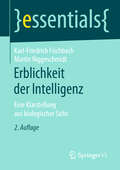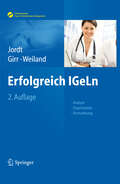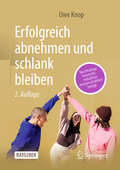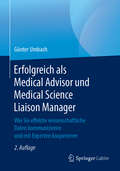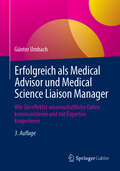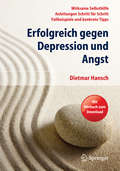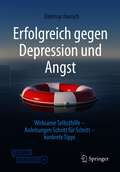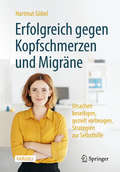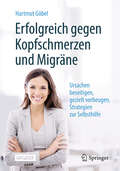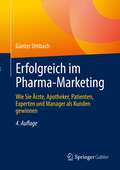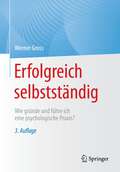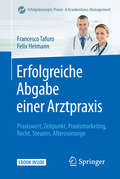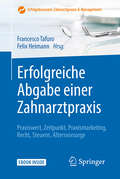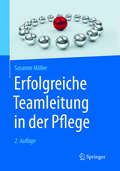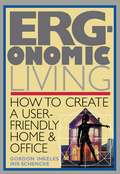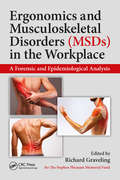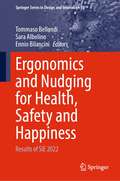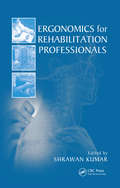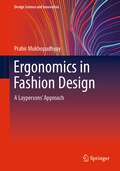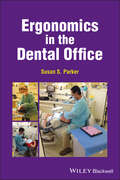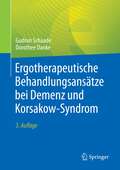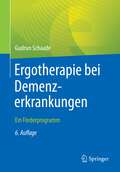- Table View
- List View
Erblichkeit der Intelligenz: Eine Klarstellung aus biologischer Sicht (essentials)
by Karl-Friedrich Fischbach Martin NiggeschmidtIst Intelligenz erblich? Karl-Friedrich Fischbach und Martin Niggeschmidt zeigen, dass „Erblichkeit“ in der biologischen Fachsprache etwas anderes bedeutet als in der Alltagssprache – was fast zwangsläufig zu Fehlinterpretationen führt. Die 2. Auflage dieses essentials wurde um Kapitel zur Aussagekraft von Zwillingsstudien und genomweiten Assoziationsstudien über IQ-Unterschiede erweitert. Wer sich die Logik der Modelle und Methoden vergegenwärtigt, stellt fest: Intelligenz als „erblich“ zu bezeichnen, ist unpräzise und irreführend. Die Autoren:Prof. Dr. Karl-Friedrich Fischbach ist Entwicklungsbiologe und Neurogenetiker. Er war von 1985 bis 2013 Professor für Biophysik und Molekularbiologie an der Universität Freiburg, davon zwei Jahre lang als geschäftsführender Direktor des Instituts für Biologie III.Martin Niggeschmidt ist Redakteur in Hamburg.Stimmen zur 1. Auflage:„... Das zugänglich geschriebene Werk erklärt faktenbasiert und anhand zahlreicher Abbildungen den komplexen Stoff, um so Missverständnisse, aber auch bewusste Falschaussagen aufzudecken.” (Arne Baudach, in: Spektrum der Wissenschaft)„... wirklich lohnenswert, ja verdienstvoll ...“ (Joachim Müller-Jung, in: Planckton, Frankfurter Allgemeine Blogs)
Erectile Dysfunction in Hypertension and Cardiovascular Disease
by Margus Viigimaa Charalambos Vlachopoulos Michael DoumasThis concise guide to the often overlooked association between erectile dysfunction and hypertension/cardiovascular disease covers a wide range of aspects of importance to the clinician. It examines the impact of antihypertensive drug therapy on erectile function and explains how the management of erectile dysfunction in hypertensive patients depends on a variety of factors. Different treatment approaches are described, including lifestyle modification, PDE-5 inhibitors and other novel agents and behavioral therapy and helpful therapeutic algorithms are presented. A further focus of the book is the potential role of erectile dysfunction as an early diagnostic indicator of asymptomatic coronary artery disease and a prognostic marker for cardiovascular events. In addition, key background information is supplied on epidemiology and pathophysiology, and the significance of erectile dysfunction in different patient groups, such as the elderly and those with chronic kidney disease, is examined. Erectile dysfunction is a major public health problem affecting more than ten percent of the general male population and is now considered to be predominantly of vascular origin. This book will be informative and of practical value for all practitioners responsible for caring for the very many patients who experience erectile dysfunction in the setting of hypertension and cardiovascular disease.
Erfassung der Pulswelle am Unterarm: Optisch-transmissives Mehrkanalsensorsystem und Simulationsmodelle
by Robert CouronnéDie nichtinvasive Erfassung des arteriellen Pulswellensignals erlaubt Pulsmessung, Pulsoximetrie bis hin zu Gefäßrisikobewertung direkt am Unterarm. Robert Couronné beschreibt zwei Modellsimulationen der Photonenausbreitung im Unterarmgewebe. Anhand gemessener Intensitäten verifiziert der Autor die erweiterte Lambert-Beer-Beziehung eines planaren Schichtenmodells und untersucht mithilfe eines Zylindermodells die Intensitätsverteilung entlang des Unterarmumfangs, wobei bevorzugte Ableitregionen identifiziert werden. Zum experimentellen Nachweis stellt der Autor den Prototyp eines optisch-transmissiven Mehrkanalsensorsystems vor und zeigt anhand von Probandenmessungen die technische Signalgewinnung und praktische Anwendbarkeit. Mit einem Klassifikationsverfahren kann die automatische Signalidentifikation sowie eine Qualitätsbewertung im Realzeitbetrieb erreicht werden. Die vorgestellten Verfahren sind dabei auf gängigen Mikrocontroller-Plattformen lauffähig.
Erfolgreich IGeLn
by Melanie Jordt Thomas Girr Ines-Karina WeilandIndividuelle Gesundheitsleistung wird zunehmend wichtig für den wirtschaftlichen Erfolg der Arztpraxis. Analyse, Organisation, Vermarktung: Welche Bedürfnisse haben meine Patienten? Welche IGeL-Leistungen will ich in meiner Praxis anbieten? Wie organisiere ich Termine, Personal, Räume? Wie biete ich meine IGeL-Leistungen an? IGeLn aus betriebswirtschaftlicher, rechtlicher und kommunikativer Sicht. Mit hilfreichen Tipps zum Umgang mit Patienten und Mitarbeitern, zur Abrechnung und Fehlervermeidung. Das interdisziplinäre Autorenteam - Arzthelferin, Ärztin, Rechtsanwalt - liefert praxisrelevant und kompakt die optimale Strategie für Ihren Erfolg.
Erfolgreich abnehmen und schlank bleiben: Nachhaltige Gewichtsreduktion wissenschaftlich belegt
by Uwe KnopDieses Sachbuch möchte allen eine ehrliche Unterstützung bieten, die ernsthaft abnehmen und ihr neues Wunschgewicht auch langfristig halten möchten. Denn: Es ist unbestritten, dass viele Frauen und Männer abnehmen wollen, und sie machen Diäten. So werden jedes Jahr aufs Neue viele Abnehmwillige mit falschen Versprechungen zur neuen„besten Diät“ hinters Licht geführt. Dieses Sachbuch geht erstmals einen anderen Weg: I DIET MY WAY - ist das neue Konzept für alle, die ihren individuellen Weg des Abnehmens maßgeschneidert bis zu ihrem persönlichen Wohlfühlgewicht gehen möchten – und anschließend dabei bleiben wollen. In diesem Buch finden Sie alles zum Thema "Kilos verlieren", was Sie wissen müssen, um langfristig abzunehmen und Ihr Wunschgewicht auch zu halten. Dabei basieren die Erkenntnisse und Empfehlungen vom Autor Uwe Knop auf den aktuellen Erkenntnissen und dem derzeitigen Konsens der WissenschaftLeicht verdaulich und unterhaltsam erfahren Sie in diesem Buch: Abnehmen ist möglich.Das Diätprinzip ist bei allen Diäten immer gleich.Das reduzierte Gewicht zu halten, ist die „hohe Kunst“. JoJo-Effekt & Co: Risiken, die Ihr Gewicht ins Schwanken bringenPraxistipps, wie Sie starten und dran bleiben Sie möchten erfolgreich abnehmen und dauerhaft schlank bleiben? Dann lesen Sie dieses Buch.
Erfolgreich abnehmen und schlank bleiben: Nachhaltige Gewichtsreduktion wissenschaftlich belegt
by Uwe KnopDieses Sachbuch bietet allen, die endlich abnehmen und ihr neues Wunschgewicht langfristig halten möchten, eine ehrliche Unterstützung. Es gibt mit dem I DIET MY WAY-Prinzip Anleitung für Ihren individuellen Weg des Abnehmens, um mit einem maßgeschneiderten Konzept Ihr persönliches Wohlfühlgewicht zu erreichen und anschließend dauerhaft beizubehalten. Die Tipps und Empfehlungen basieren dabei auf den aktuellen wissenschaftlichen Erkenntnissen zu Gewichtsverlust, Ernährung und Lebensstilveränderung. In einer Zeit, in der fast wöchentlich neue Diäten und Food-Trends entstehen, vereint dieses Buch fundiertes Wissen mit ehrlichem Klartext für anhaltende Gewichtsreduktion. Es ist damit zum einen besonders für Personen geeignet, die erstmals abnehmen und sich im Vorhinein über die richtige Herangehensweise informieren möchten, damit sie nicht in die JoJo-Falle tappen – aber auch für all diejenigen, die bereits Abnehmversuche hinter sich haben und sich fragen, warum diese nicht zum Erfolg geführt haben. In der aktualisierten zweiten Auflage wird das erfolgreiche Konzept durch die neuesten gesellschaftlichen Entwicklungen und wissenschaftlichen Erkenntnisse ergänzt. Leicht verdaulich und unterhaltsam erfahren Sie: Das Wirkprinzip ist bei allen „klassischen&“ Diäten immer gleich. Das reduzierte Gewicht zu halten, ist die „hohe Kunst&“. Jo-Jo-Effekt & Co: Risiken, die Ihr Gewicht ins Schwanken bringen. Praxistipps: Wie Sie starten und dranbleiben. Eine unverzichtbare Hilfe, um erfolgreich abzunehmen und dauerhaft schlank zu bleiben!
Erfolgreich als Medical Advisor und Medical Science Liaison Manager: Wie Sie effektiv wissenschaftliche Daten kommunizieren und mit Experten kooperieren
by Günter UmbachDieses Buch gibt Medical Advisors, medizinisch-wissenschaftlichen Fachreferenten und Medical-Marketing-Managern der Arzneimittelindustrie das erforderliche Know-how zur Realisierung des vollen medizinischen und wirtschaftlichen Potenzials eines Arzneimittels.
Erfolgreich als Medical Advisor und Medical Science Liaison Manager: Wie Sie effektiv wissenschaftliche Daten kommunizieren und mit Experten kooperieren
by Günter UmbachDieses Buch gibt Medical Advisors, medizinisch-wissenschaftlichen Fachreferenten und Medical-Marketing-Managern der Arzneimittelindustrie das erforderliche Know-how zur Realisierung des vollen medizinischen und wirtschaftlichen Potenzials eines Arzneimittels. Die dritte Auflage wurde umfassend aktualisiert und um wichtige Aspekte zu den Themen Künstliche Intelligenz in der Pharmaindustrie, digitale Meetings, optimierte Sichtbarkeit im Internet, Kundenreise, Touchpoints und Abgrenzung gegenüber "Commercial" ergänzt.
Erfolgreich gegen Depression und Angst
by Dietmar HanschFühlen Sie sich niedergeschlagen und energielos? Sind Sie ständig überlastet und unzufrieden? Leiden Sie unter Ängsten und körperlichen Reaktionen wie Schwindel, Herzrasen oder -schmerzen? Der Ratgeber hilft Ihnen bei der Entscheidung, ob eine Erkrankung vorliegt, Selbsthilfe möglich oder ein Arztbesuch nötig ist. Hilfe zur Selbsthilfe bei Depression und Angst: Ursachen und Eskalationsmechanismen bei Depression, Burnout, Angst- und Panikstörung werden erklärt Schritt für Schritt die Eskalation unterbrechen, Energie gewinnen, die Ausgangsprobleme lösen Ausführliche und umsetzbare Aufgabenstellungen, die Ihnen helfen, Ihre gesamte Lebenssituation zu optimieren Im Rahmen einer ganzheitlichen Lebenskunst das Gesunde fördern und die Stärken stärken Geeignet auch als Begleitmaterial für Psychotherapie (insbesondere kognitive und achtsamkeitsbasierte Verhaltenstherapie) Mit Hörbuch zum DownloadGeschrieben für Klienten mit Angststörung und Depression, ihre Angehörigen - zur Empfehlung durch Psychotherapeuten, Psychiater, Klinische Psychologen, Mitarbeiter in Beratungsstellen.
Erfolgreich gegen Depression und Angst: Wirksame Selbsthilfe - Anleitungen Schritt für Schritt - konkrete Tipps
by Dietmar HanschDieser Ratgeber hilft allen, die sich niedergeschlagen und energielos fühlen, ständig überlastet und unzufrieden sind, unter Ängsten und körperlichen Reaktionen wie Schwindel, Herzrasen oder -schmerzen leiden. Er hilft Ihnen bei der Entscheidung, ob eine Erkrankung vorliegt, Selbsthilfe möglich oder ein Arztbesuch nötig ist. Wenn das Lesen noch schwer fällt, steht Ihnen ein einführendes kostenloses Hörprogramm zum Download zur Verfügung. Aus dem Inhalt: Ursachen und Eskalationsmechanismen bei Depression, Burnout, Angst- und Panikstörung werden erklärt – Schritt für Schritt die Eskalation unterbrechen, Energie gewinnen, die Ausgangsprobleme lösen – Ausführliche und umsetzbare Aufgabenstellungen, die Ihnen helfen, Ihre gesamte Lebenssituation zu optimieren – Im Rahmen einer ganzheitlichen Lebenskunst das Gesunde fördern und die Stärken stärken – Geeignet auch als Begleitmaterial für Psychotherapie (insbesondere kognitive und achtsamkeitsbasierte Verhaltenstherapie). Über den Autor: Dr. med. Dietmar Hansch ist Facharzt für Innere Medizin/Psychotherapie und Autor zahlreicher Bücher.
Erfolgreich gegen Kopfschmerzen und Migräne: Ursachen beseitigen, gezielt vorbeugen, Strategien zur Selbsthilfe
by Hartmut GöbelIn diesem Buch informiert der renommierte Kopfschmerzexperte Professor Dr. Hartmut Göbel über Formen und Ursachen von Kopfschmerzen und Migräne sowie über moderne Diagnosemöglichkeiten und Therapieverfahren, inklusive alternativer Behandlungsverfahren. Darüber hinaus erhalten Betroffene wichtige Informationen und Tipps zur Selbsthilfe und Vorbeugung. Dazu gehören u.a. zahlreiche Adressen von Selbsthilfegruppen und Kliniken, Tipps zur richtigen Einnahme von Medikamenten und Hinweise auf wertvolle Serviceseiten im Internet. Die 9.Auflage erscheint komplett überarbeitet und erweitert. Neue Themen sind u.a. Vorbeugung von Migräne- und Kopfschmerzen bei Kindern und Jugendlichen, Ernährung und Migräne, neue Medikamente zur Attackentherapie, Immuntherapie mit CGRP-Antikörper und wirksame digitale Versorgung mit der Migräne-App. · ·
Erfolgreich gegen Kopfschmerzen und Migräne: Ursachen beseitigen, gezielt vorbeugen, Strategien zur Selbsthilfe
by Hartmut GöbelIn diesem Buch informiert der renommierte Kopfschmerzexperte Professor Dr. Hartmut Göbel über Formen und Ursachen von Migräne und Kopfschmerzen sowie über moderne Diagnosemöglichkeiten und Therapieverfahren, inklusive alternativer Behandlungsverfahren. Darüber hinaus erhalten Betroffene wichtige Informationen und Tipps zur Selbsthilfe und Vorbeugung. Dazu gehören u.a. zahlreiche Adressen von Selbsthilfegruppen und Kliniken, Tipps zur richtigen Einnahme von Medikamenten und Hinweise auf wertvolle Serviceseiten im Internet. Die 10.Auflage erscheint komplett überarbeitet und erweitert. Neue Themen sind u.a. die Einführung neuer Medikamente wie Antikörper gegen den CGRP-Rezeptor oder das CGRP selbst, Ditane, Gepante, digitale Behandlungsoptionen, Neurostimulation, Entspannungstechniken und Stressmanagement. ·
Erfolgreich im Pharma-Marketing: Wie Sie Ärzte, Apotheker, Patienten, Experten und Manager als Kunden gewinnen
by Günter UmbachWerden Sie von diesem Buch profitieren? Ja, insbesondere wenn Sie im Marketing oder Produktmanagement der Arzneimittel- oder Medizinprodukte-Industrie tätig sind. Sie finden aktuelles Know-how mit Beispielen, Fallstudien und Empfehlungen auch zu digitalen Strategien und Taktiken wie beispielsweise Websites, Newsletter, Online-Videos, Podcasts, Content Marketing, Online-Sichtbarkeit, Search Engine Optimization (SEO), etc.
Erfolgreich selbstständig: Wie gründe und führe ich eine psychologische Praxis?
by Werner GrossDieses Buch ist ein Leitfaden zur Selbstständigkeit in den verschiedenen Berufsfeldern der Psychologie. Von der generellen Eignung selbstständig in einer (freien) psychologischen Praxis tätig zu werden, über Finanzierungsmöglichkeiten, den Gründungsprozess der eigenen Praxis bis hin zu Detailfragen wie Honorargestaltung beantwortet der Autor die wichtigsten Fragen der Existenzgründung als Psychologe oder Psychologin. Bei vielen Studierenden an der Schwelle zum Beruf, aber auch bei angestellten Psychologen besteht ein großer Informationsbedarf, wenn es um Kalkulationen, Konzepte, Kapital und Klienten geht. Und selbst „alte Hasen“ können davon profitieren – und sei es nur, um zu prüfen, ob sie bei ihrer Selbstständigkeit auch an alles gedacht haben. Hilfreich sind dabei Links zu Video-Clips des Autors. Aus dem Inhalt: Was müssen angehende Psychotherapeuten oder Psychotherapeutinnen auf ihrem Weg in die Selbstständigkeit beachten? – Welche Chancen hat man in der Rechtspsychologie? – Welche Optionen bietet die freie Wirtschaft? – Kann man von den Honoraren als Coach, Mediator oder Supervisor leben? – Welche Vorstellungen und Orientierungen sind dringend erforderlich, und wie steht es um das liebe Geld? – Wo sind die Gefahren und Klippen der Selbstständigkeit? Der Autor: Werner Gross, niedergelassener Psychotherapeut, Coach und Unternehmensberater ist Experte des BDP für Existenzgründungsfragen und führt seit über 30 Jahren Seminare für Psychologen und Psychotherapeuten durch.
Erfolgreiche Abgabe einer Arztpraxis: Praxiswert, Zeitpunkt, Praxismarketing, Recht, Steuern, Altersvorsorge (Erfolgskonzepte Praxis- And Krankenhaus-management Ser. #1)
by Francesco Tafuro Felix HeimannWollen niedergelassene Ärzte mit dem Ende ihrer Berufstätigkeit ihre Praxis übergeben, sind zahlreiche Fragen zu bedenken. So ist für eine gelungene Übergabe nicht nur das subjektive „gute Gefühl“ von Bedeutung, auch die persönlichen und fachlichen Erwartungen des übernehmenden Arztes sowie die Bedürfnisse des Praxisteams und der Patienten sind zu berücksichtigen. Der Band liefert das Handwerkszeug, um die Übergabe einer Arztpraxis erfolgreich zu gestalten: von der Analyse bis zur Umsetzung. Der der Autor erläutert die Erfolgsfaktoren.
Erfolgreiche Abgabe einer Zahnarztpraxis: Praxiswert, Zeitpunkt, Praxismarketing, Recht, Steuern, Altersvorsorge (Erfolgskonzepte Zahnarztpraxis And Management Ser.)
by Francesco Tafuro Felix HeimannWer seine Zahnarztpraxis mit einem guten Gefühl an einen Nachfolger übergeben möchte, hat häufig viele Fragen. Dieses Buch zeigt auf, welche persönlichen und fachlichen Erwartungen der übernehmende Zahnarzt hat. Außerdem wird erörtert, welchen Ansprüchen die Praxis genügen sollte und welche Wünsche und Erwartungen das Praxisteam und die Patienten haben. Übersichtlich werden Analyse, Konzepte und Umsetzung vorgestellt. Online specials ergänzen die Ausführungen, damit eine erfolgreiche Übergabe sicher gelingt.
Erfolgreiche Teamleitung in der Pflege
by Susanne MöllerFit für die Teamleitung - Einstieg in die neue Führungsrolle Es ist noch kein Meister vom Himmel gefallen - so kann und muss auch die Führung eines Teams gelernt werden. Dieser Ratgeber bietet allen Pflegenden Unterstützung, die eine erste Teamleitungsfunktion übernehmen. Schritt für Schritt werden Sie an die Anforderungen und Aufgaben herangeführt, lernen Prozesse im Team zu lenken, Konflikte zu lösen, Mitarbeitergespräche zu führen und wachsen so in die neue Rolle hinein. Anhand zahlreicher Fallbeispiele aus Ihrem Berufsalltag werden Zusammenhänge erläutert und kurze Übungen ermöglichen ein Ausprobieren und Anwenden. Erfahren Sie mehr über Erfolgsfaktoren funktionierender Teams, Prozess der Teamentwicklung, Aufgaben und Selbstverständnis der Teamleitung, Einflussfaktoren im Teamalltag: Wahrnehmung, Sprache, Stress, Positives Denken, "Spielregeln" für die Teamarbeit, wertschätzende Kommunikation, Grenzen der Teamführung. Für Pflegende mit erster Teamverantwortung in Krankenhäusern, der ambulanten und stationären Pflege aber auch in niedergelassenen Praxisteams.
Ergonomic Living: How to Create a User-friendly Home and Office
by Gordon Inkeles Iris SchenckeYou work indoors. You're not on your feet all day and you do not do heavy lifting, and yet you feel exhausted at the end of every day. Maybe you're being attacked by your possessions. Perhaps you have an old worn out mattress, an old office chair that won't let you sit straight, a computer screen that you struggle to read. This book will show you how to find the perfect furniture to allow you to work or live in the safest, most effective, and most comfortable manner.
Ergonomics and Musculoskeletal Disorders (MSDs) in the Workplace: A Forensic and Epidemiological Analysis
by Richard GravelingWhether you call them work-related upper limb disorders (WRULDs), cumulative trauma disorders (CTDS), or occupational overuse syndromes (OOSs), these conditions are a cause of pain, disability and suffering to workers worldwide. These designations often imply that their causes are related to work, but the supporting evidence can be unclear. Transparency is important, especially when it is necessary to form a connection with work factors to obtain treatment or compensation. This book addresses the dilemma. Written by a professional ergonomist with almost 40 years of experience in workplace ergonomics, this book combines a critical summary and assessment of the epidemiological literature with an exploration of the scientific and medical evidence for possible causal mechanisms to develop well-informed conclusions on causation of a number of common musculoskeletal disorders of the upper limb and intervertebral disc injury. Although much of the book focuses on physical factors, the role of psychosocial factors is increasingly being recognized and an additional chapter reviews a number of the current theories relating to this important issue. Features Focuses on a clear and authoritative account of the evidence for the role of work in the causation of commonly occurring ULDs and disc injury Provides an up-to-date compilation of the scientific evidence, devoid of views based on assumptions or prejudice Presents a clear explanation of the most likely causal mechanisms for common ULDs and disc injuries Includes a summary of theories concerning the role played by psychosocial factors Outlines the statistical evidence in a clear and understandable manner Bridges the gap between the evidence-base in the scientific and medical research literature and the practitioner
Ergonomics and Nudging for Health, Safety and Happiness: Results of SIE 2022 (Springer Series in Design and Innovation #28)
by Sara Albolino Ennio Bilancini Tommaso BellandiThis book presents the best, peer-reviewed contributions from the XII Congress of the Italian Society of Ergonomics and Human Factors (SIE), held in Lucca, Italy, on May 2-4, 2022. By highlighting the latest theories and models, as well as cutting-edge technologies and applications, and by combining findings from a range of disciplines including engineering, design, robotics, management, computer science, human biology and behavioral sciences, it provides researchers and practitioners alike with a comprehensive, timely guide on human factors and ergonomics in a variety of industrial sectors, such as health care, transportation, automotive and constructions. It also offers an excellent source of innovative ideas to stimulate future discussions and developments aimed at applying knowledge and techniques to optimize system performance, while at the same time promoting health, safety, and well-being of individuals anc communities. The proceedings includes papers from researchers and practitioners, scientists and physicians, institutional leaders, managers, and policy makers that contribute to constructing the Human Factors and Ergonomics approach across a variety of methodologies, domains, and productive sectors.
Ergonomics for Rehabilitation Professionals
by Shrawan KumarDespite the apparently distinct differences between the disciplines of ergonomics and rehabilitation, they deal with the same issues, although at different ends of the spectrum. Keeping this in mind, Ergonomics for Rehabilitation Professionals explores their philosophies and goals, their parallel, divergent, and complementary aspects. It traces the
Ergonomics in Fashion Design: A Laypersons' Approach (Design Science and Innovation)
by Prabir MukhopadhyayThis volume discusses the relevance of different ergonomic principles in fashion, lifestyle, and accessory design. Written in a simple and concise language, the book makes the subject interesting to those unfamiliar with the technicalities in ergonomics. The contents provide a broad overview of the relevance of ergonomics in fashion design, and touches upon the systems aspects of ergonomics in fashion design. It also includes ergonomic issues like dimensions, adornment of different body parts, thermoregulation through clothing. The volume highlights the application of ergonomics in different domains of fashion (sports, medicine, etc) followed by ergonomic issues in fashion designing for elderly and the disabled. Ergonomic issues in fashion design for different context like crowded places, mass transportation etc are also discussed. This volume will be of interest to those in academia and industry alike.
Ergonomics in the Dental Office
by Susan S. ParkerHelps everyone on the dental team work in a more comfortable and less painful way Dental health providers commonly struggle with chronic back pain, carpal tunnel syndrome, muscle tension, strained eyes, and other work-related musculoskeletal problems. Ergonomics in the Dental Office provides clear guidance on alleviating or eliminating the pain and discomfort caused by strains put on the body in daily practice. This easy-to-read book explains the principles of ergonomics, identifies specific causes of musculoskeletal problems, and presents simple—yet effective—techniques to address the physical stresses that might be occurring in the dental office. Concise, highly visual chapters demonstrate correct postures, clock positions, instrument transfer, head and neck placement, instrumentation techniques, office design, and more. The author emphasizes the importance of daily exercises, rest breaks, and disciplines that relieve both physical and emotional stress such as yoga and Tai Chi. Topics include occupational health issues and research, treating disabled patients, developing ergonomic awareness, seat positioning for tall and short operators, integrated intervention planning, and signs and symptoms of musculoskeletal disorders. Presents ways to improve body positioning and instrumentation techniques, including basic ergonomic principles of proper four-handed dentistry Discusses exercises to reduce stress and reduce muscle fatigue, such as Pilates, free weights, and aquatic activities Covers all key aspects of ideal dental office ergonomics, including furniture, equipment, office layout and design, and practice assessment Designed to address a problem all dental professionals face, Ergonomics in the Dental Office is an invaluable book for dentists, dental hygienists, dental assistants, and dental students and trainees.
Ergotherapeutische Behandlungsansätze bei Demenz und Korsakow-Syndrom
by Gudrun Schaade Dorothee DankeAufbauend auf dem Lehrbuch „Ergotherapie bei Demenzerkrankungen" vertieft das Praxisbuch neue Behandlungs- und Betreuungsstrategien. Dabei baut die Autorin auf bekannte Therapiekonzepte für verhaltensgestörte Kinder (Sensorische Integration) und Schwerstbehinderte (Basale Stimulation) auf. Sie erläutert die Therapien für die unterschiedlichen Krankheitsphasen anhand von Handlungsempfehlungen und Fallbeispielen. Eine Einführung zu Aufbau und Funktionen des Gehirns bildet die Grundlage für die effektive Anwendung dieser Konzepte bei Demenzkranken.
Ergotherapie bei Demenzerkrankungen: Ein Förderprogramm
by Gudrun SchaadeDer Band stellt ein praxiserprobtes Förderkonzept für die Arbeit mit an Demenz erkrankten Patienten vor und liefert zugleich notwendiges Grundlagenwissen. Insbesondere wird aufgezeigt, wie gängige rehabilitative Behandlungsansätze mit anderen Methoden kombiniert werden können, die speziell auf die Möglichkeiten von Demenz-Patienten abgestimmt sind. Handlungsanleitungen und ein umfangreicher Fundus an Übungsvorschlägen liefern Anregungen für die praktische Umsetzung. Geeignet als Einstiegslektüre für einen anspruchsvollen Aufgabenbereich.
